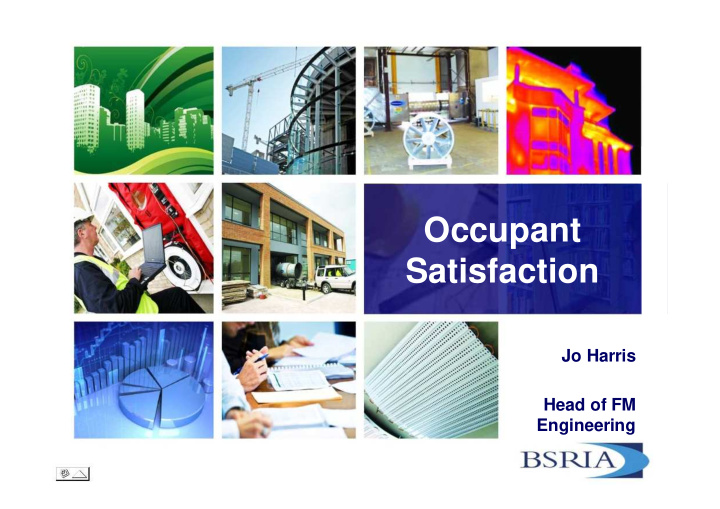



Occupant Satisfaction Jo Harris Head of FM Engineering
Who are occupants? � Users � Operators – Office works – Engineers – School children – Cleaners – Hospital patients – Security – Scientists – Receptionists – Home owners – DIY enthusiasts 2 The built environment experts
Why do we worry about them? � We want…. � The problem is… – Improved building – Complex technologies are performance harder to commission and operate – Least amount of energy consumed – Occupiers interfere! 3 The built environment experts
What can we learn from them? � Comfort � Usability � Maintainability � Manageability � Sustainability 4 The built environment experts
What can we measure? � Building design � Usability – Thermal comfort – Layout – Indoor air quality – Furnishing – Lighting – Control – Acoustics – Productivity?? � Maintainability – Maintenance – Cleanliness – Energy 5 The built environment experts
Barriers to measurement � Designers � Facilities managers – Liability – Can of worms… – Litigation – Reputation 6 The built environment experts
What can we do with the results? � Measure project success and value � Operators and users can provide feed back on what works and what doesn’t � Inform design for the next project � Encourage proactive building management 7 The built environment experts
What methodologies are there? � � AMA Workware Toolkit HEAPS � � ASTM Standards HEDQF POE Forum � � AUDE & UW Guide HOBO � � BRE Design Quality Method Learning from Experience � � BREEAM MARU Evaluation Studies � � BUS Occupant Survey OBU Healthcare POE Method � � CIC DQIs OPN Survey � � CSH Overall Liking Score � � DEEP POE 1st year Occupancy � � DREAM School Assessment � � Healthcare Design Quality School Works Source: Usable Buildings Trust – POE Methodology review 8 The built environment experts
How to assess occupant satisfaction? � Occupant survey – As short as possible – Warn them – Hand deliver � Observations – Unobtrusive � Interviews – Listen 9 The built environment experts
An example 10 The built environment experts
What did we do? � Surveyed staff – BUS methodology – Generic questionnaire for permanent users � Measured – Noise – Temperature – Energy 11 The built environment experts
BUS Methodology results Benchmark Negative Positive Red - Significantly worse Amber – Within benchmark Green - Significantly better 12 The built environment experts
What did we learn? � Bad � Good – Control over cooling, – Humidity heating, ventilation, lighting – Odourless – Temperature varies, winter, – Furniture summer – Glare – Stuffy, draughty – Meeting Rooms – Health (perceived) – Noise from colleagues, other people, outside – Productivity (perceived) – Space at desk 13 The built environment experts
Comments are also useful… � Problems � Solutions – I work more slowly when – Most problems between cold seasons winter / spring – Having to request – Noise should be cooling is tedious improved by staff – I get frustrated by noise behaviour and interruptions and – Probably not necessary am less productive and to have all lights on all focussed day need to improve – Use headphones / switching music to block noise when need to concentrate 14 The built environment experts
What did we do about it? � Upgraded controls � Temperature varies, winter, summer � Stuffy, draughty � Still to address � Control over cooling, heating, ventilation, lighting � Health (perceived) � Noise from colleagues, other people, outside � Productivity (perceived) � Space at desk 15 The built environment experts
Summary � Occupants… – Are users and operators � We want… – Improved building performance, least amount of energy � The problem is… – Complex technologies, operation is not intuitive � The solution is… – To engage occupants � Benefits – Measure project success and value – Inform design for the next project – Encourage proactive building management 16 The built environment experts
Recommend
More recommend